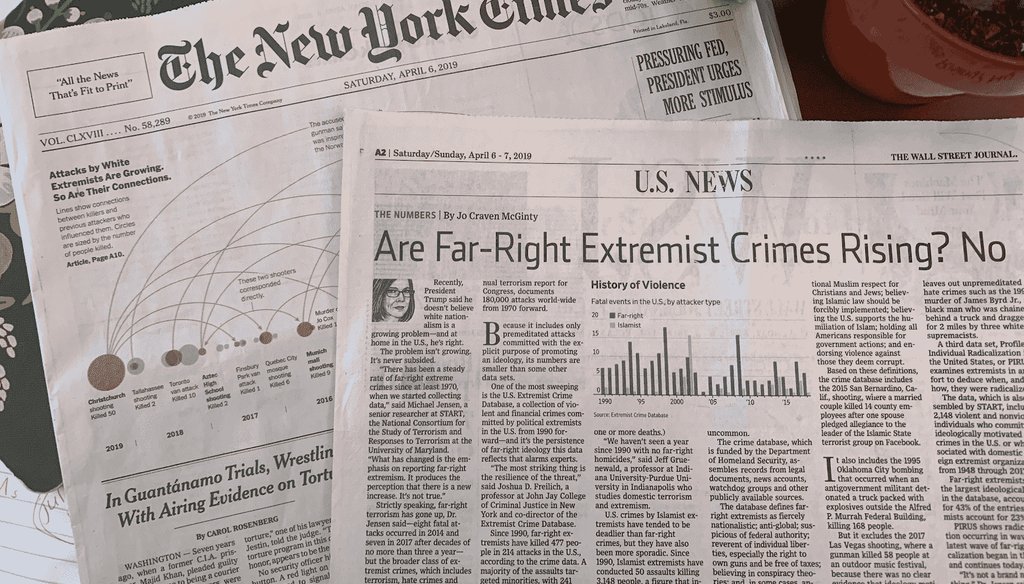Stand up for the facts!
Our only agenda is to publish the truth so you can be an informed participant in democracy.
We need your help.
I would like to contribute

Coverage in the April 6, 2019, editions of the New York Times and Wall Street Journal uses different frames for far-right extremism. (PolitiFact Photo)
A glance at the headlines of two major newspapers this weekend might have left readers confused about whether far-right extremism is getting worse.
On the front page of the April 6 New York Times was a headline that read, "Attacks by White Extremists Are Growing. So Are Their Connections."
That same day, the Wall Street Journal carried a story headlined, "Are Far-Right Extremist Crimes Rising? No."
These dueling headlines certainly look like conflicting narratives. How could these outlets seem to arrive at such different conclusions?
The short answer, PunditFact found: The newspapers measured different things.
Sign up for PolitiFact texts
They examined different kinds of perpetrators, covered different geographic areas and used different time frames. Additionally, some imprecise wording in both headlines — plus analytical fuzziness by the Wall Street Journal — added to the confusion.
Overall, our review suggests that terrorist attacks by far-right extremists are going up in certain parts of the world. Separately, the more general category of homicides by far-right extremists — which includes terrorist attacks — have basically held steady in the United States for decades, according to at least one major U.S. extremist crime database.
New York Times: White extremist terror attacks on the rise
The New York Times focused exclusively on white extremist terrorist attacks, while the Wall Street Journal explored a broader range of far-right homicides, of which terrorism is a small subset.
To tally the numbers, the New York Times relied on the Global Terrorism Database. This dataset, which goes back to 1970, essentially defines terrorism as intentional acts of violence by non-government actors to achieve political or religious goals, or to sow fear. (You can read their precise definition here.)
The Global Terrorism Database — which is maintained by the University of Maryland’s National Consortium for the Study of Terrorism and Responses to Terrorism — has not systematically coded for attackers’ ideology. So to obtain a count of terrorist attacks carried out by white extremists in particular, the New York Times performed additional analysis.
Ultimately, the New York Times landed on a definition of "white extremist" that encompassed white nationalist, white supremacist, neo-Nazi, xenophobic, anti-Muslim and anti-Semitic ideologies. (A full explanation of their methodology is here.)
The New York Times identified 347 white extremist terrorist attacks in Europe, North America and Australia from 2011 through 2017, and included some preliminary data on U.S. attacks in 2018. The Wall Street Journal, for its part, used different geographic and temporal slices.
For the New York Times, their choice of data served dual functions. In addition to charting numerical trends, the journalists also drew ideological connections between high-profile incidents, to illustrate what the paper described as "an informal global network of white extremists."
For instance, the article notes that the shooter who killed 50 people in an attack on two mosques in Christchurch, New Zealand, drew inspiration from far-right extremist Anders Behring Breivik, who killed 77 in Norway in 2011, as well as other perpetrators.
"All these attacks occurred amid a surge of white supremacist and xenophobic terrorism in the West that has frequently targeted Muslims, immigrants and other minority groups," the New York Times reported. The following graph, which ran alongside the story, shows the uptick in white extremist terror attacks over the relevant period:
Source: The New York Times.
Wall Street Journal: Far-right homicides in U.S. have held steady
While the New York Times looked only at white extremist terror attacks, the Wall Street Journal sought to focus primarily on the more general category of far-right homicides. But along the way, it made several additional assertions, including some that were unsubstantiated, and which PolitiFact was unable to confirm.
The article appeared as part of the Wall Street Journal’s weekly Numbers column, which, gives a "look at the use of numbers in news, business and politics."
A spokesperson for the Journal characterized the article’s thesis as follows: While far-right terrorism is up, far-right homicides — including those which do not meet the definition of terrorism — have essentially held steady for decades.
In contrast to the New York Times’ coverage, the spokesperson said, "The Journal chose to report on the broader category of fatal attacks."
To back up its assertion about far-right homicides staying flat, it relied on the U.S. Extremist Crime Database. This crime database tracks not only terror attacks, but also incidents that aren’t captured in the Global Terrorism Database, like financial and certain violent crimes by adherents of an "extremist belief system." (You can read their methodology here).
If the Wall Street Journal had looked only at far-right homicides over time, its thesis would be clearly backed up with hard numbers, as the following graph that accompanied the Journal article shows.
Source: The Wall Street Journal, citing data from the U.S. Extremist Crime Database.
But the Wall Street Journal article went out on a limb — several limbs, in fact.
The headline on the digital version says that far-right extremist crime — not just homicides, but also "hate crimes and related violence" — have held steady since at least 1970. But it does not back this broader claim up with hard numbers.
For instance, the article presents no data to show that far-right vandalism targeting minorities has held steady for decades, notes Erin Miller, who manages the Global Terrorism Database. The directors of the Extremist Crime Database also did not provide PunditFact with evidence about non-fatal extremist crimes.
The Journal article also waded into the controversial debate over President Donald Trump’s recent statements about white nationalism. The article’s first sentence says that Trump is correct that white nationalism is not on the rise in the United States. Yet the article never defines "white nationalism" — in fact, the term is not mentioned a second time.
As we’ve written, data from multiple sources suggest extremist attacks associated with white nationalism and far-right ideology are on the rise.
According to Miller of the Global Terrorism Database, the Wall Street Journal seems to have blurred some key distinctions.
The article appears to conflate far-right extremist crimes (which include both violence and non-violence) and white nationalism (an idea), Miller said, and then uses the number of fatal events (a small subset of extremist crimes) to represent both.
"I think the author of the article attempted to disentangle these concepts somewhat," she said. "But referencing various datasets in the same analysis is extremely difficult and prone to confusion."
In fairness, the headlines of both the New York Times and Journal articles can be faulted for imprecision. It’s also worth noting that reporters do not always have final say over headlines.
"Arguably, the New York Times title should reference ‘terrorist attacks’ instead of ‘attacks,’ " Miller said.
David Sterman, a policy analyst at the left-leaning think tank New America, said the weekend’s coverage highlighted the need for more data-driven research — as well as greater transparency and precision.
"Overall this is an important debate that needs to occur with clarity regarding definitions and objectivity," he said.
Our Sources
New York Times, "Attacks by White Extremists Are Growing. So Are Their Connections," April 3, 2019
Wall Street Journal, "Are Far-Right Extremist Crimes Rising? No," April 5, 2019
PolitiFact, "Donald Trump doesn’t think white nationalism is on the rise. Data show otherwise," March 20, 2019
Email interview with David Sterman, a policy analyst at New America, April 9, 2019
Email interview with Heidi Beirich, of the Southern Poverty Law Center, April 9, 2018
Email interview with J.M. Berger, a research fellow with VOX-Pol and an expert on extremism, April 9, 2019
Email interview with Colleen Schwartz, a spokesperson for the Wall Street Journal, April 9, 2019
Email interview with Erin Miller, program manager of the Global Terrorism Database at the University of Maryland’s National Consortium for the Study of Terrorism and Responses to Terrorism, April 9, 2019
Email interview with Michael Jensen, data collection manager of the Global Terrorism Database at the University of Maryland’s National Consortium for the Study of Terrorism and Responses to Terrorism, April 9-10, 2019
Email interview with Josh Freilich, co-director of the U.S. Extremist Crime Database, April 10, 2019


















































